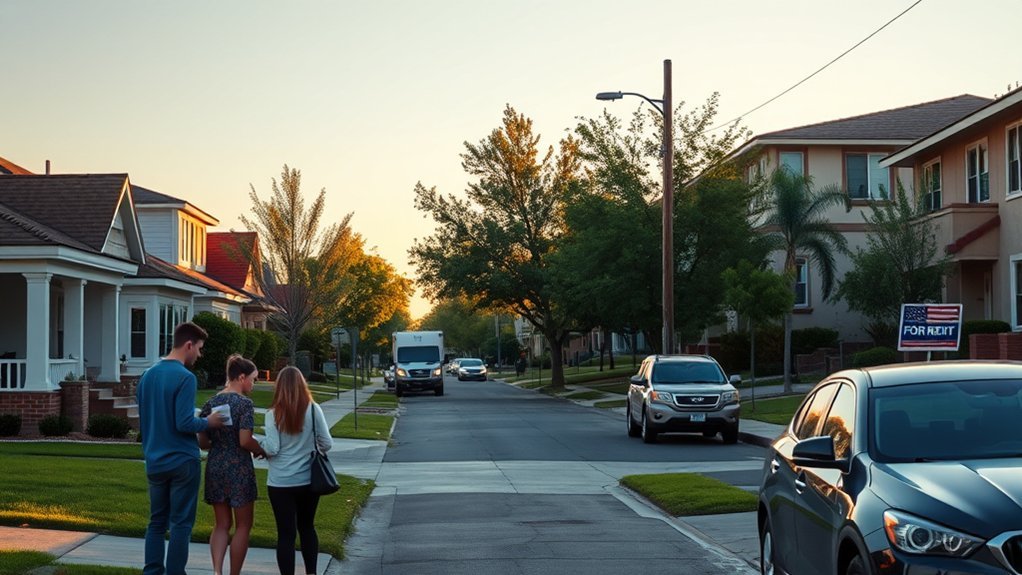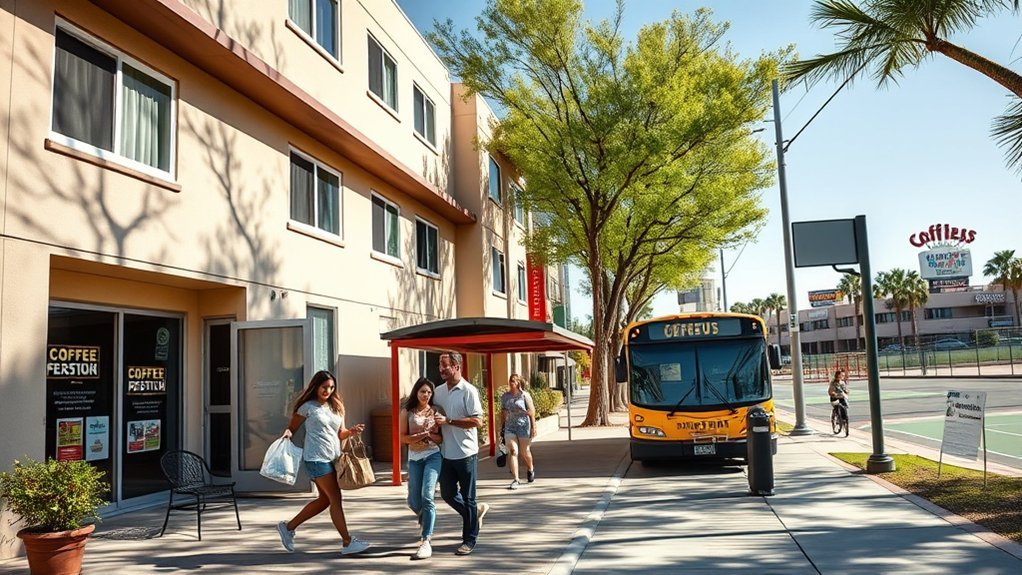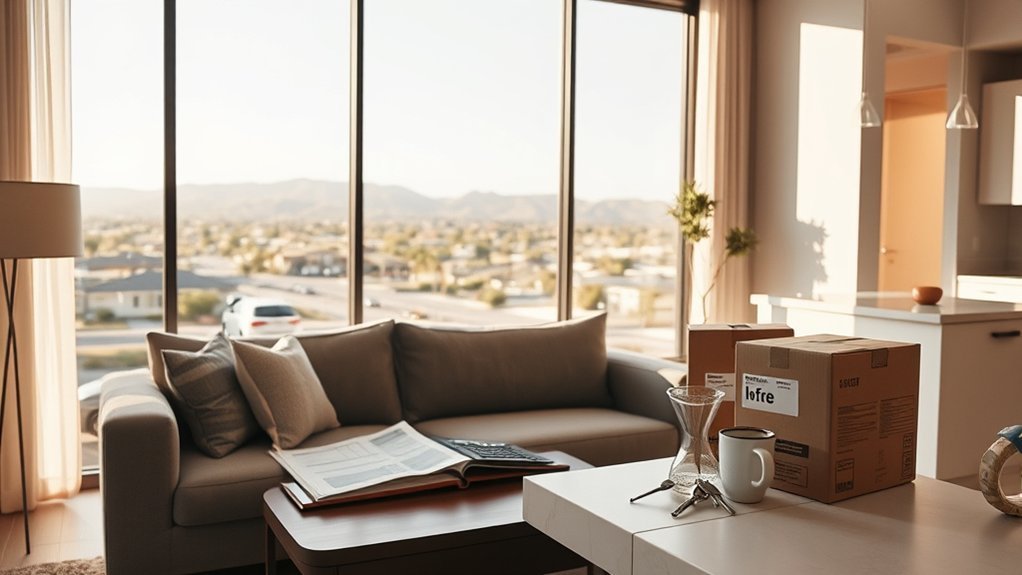If you’re planning a move to Henderson, you’ll want a clear, data-driven snapshot of monthly costs so you can budget smartly. Housing is the biggest factor — median home prices and one- to two‑bedroom rents drive the local index — but utilities, groceries, transport, and healthcare add up too. I’ll break down typical monthly figures, tax impacts, and the salary you’ll need to live comfortably so you can decide your next steps.
Cost of Living Overview and Key Indexes

Because Henderson sits about 10.6% above the U.S. average on overall cost of living (index ~110.6), you’ll feel the pinch mainly from housing: the housing index is roughly 136.5 with a median home price near $449,100 and typical rents around $1,661 (1-BR ~$1,353; 2-BR ~$1,601–$1,691).
Henderson runs about 10% pricier than average — housing drives costs, with median home ~$449K and rents near $1,660.
Your monthly budget will need to account for these elevated housing costs first. Beyond housing, groceries run slightly above average (grocery index ~104.7), so plan grocery line items a few percent higher than the national norm.
Utilities sit near parity (utilities index ~100.7), though summer A/C spikes can raise bills. Healthcare is cheaper than average (health index ~93.0), which offsets some pressure. Additionally, understanding building costs can help in evaluating future housing options in the area.
Nevada’s state income tax (none) improves take-home pay, but sales tax plus local additions — up to about 8.14–8.375% — raises everyday expenses. Use these core indexes to build a precise monthly budget focused on housing, groceries, utilities, and sales-tax–affected spending.
Rent, Home Prices, and Neighborhood Comparisons

Although housing here runs noticeably above the national norm, you’ll find a range of options from entry-level rentals to ultra‑luxury estates: median home prices sit roughly between $449K and $491K (housing index ~136.5), while typical rents in early 2025 cluster around $1,545 for studios, $1,353–$1,442 for one‑bedrooms, and $1,601–$1,691 for two‑bedrooms, with citywide averages about 11% below the U.S. rent average but wide neighborhood variation (e.g., MacDonald Highlands $7K–$12.5K/month vs. 3)
You’ll monitor Henderson rent and median rent figures to plan monthly housing expenses. Expect a median home cost that reflects premium neighborhoods like MacDonald Highlands and Green Valley Ranch, where a two-bedroom apartment commands a high premium. More affordable neighborhoods — Lamancha Townhouse, South Valley, Vista North Green Valley and Pittman — offer lower entry points, with one-bedroom and two-bedroom apartment options often several hundred dollars cheaper. Use a neighborhood rent comparison to balance commute, amenities and price; targeted searches will show where median rent and home costs best match your budget. Additionally, understanding related costs such as air conditioning and maintenance can further help you budget effectively for living in Henderson.
Monthly Budget Breakdown: Utilities, Food, Transportation, and Healthcare

Break down your monthly non-housing costs into clear line items so you can see where the roughly $2,493 average for a single person goes: utilities run about $185–$226 (about 13% above the national average, with summer electricity spikes), food averages $370 for a typical adult but can range $500–$1,000 depending on habits, transportation is roughly $421/month (or about $10,356 annually by MIT’s estimate) with a $65 RTC 30‑day pass as a lower-cost option, and healthcare sits around $200–$275 monthly with Henderson’s health index at 93.0. Regular inspections can help prevent costly issues such as air conditioning hose replacement in your vehicle, thereby saving money in the long run.
| Category | Typical monthly cost |
|---|---|
| Utilities (water, electric, gas, internet) | $185–$226 |
| Groceries & dining | $370 (can be $500–$1,000) |
| Transportation & healthcare | $421; $200–$275 |
You’ll compare these line items against average rent and other monthly expenses to assess total cost of living. If you use RTC transit instead of a car, or live near Lake Las Vegas, you can trim transportation and groceries modestly.
Taxes, Income, and What Salary You Need to Live Comfortably

If you’re weighing take-home pay against Henderson’s costs, Nevada’s lack of a state income tax gives you an immediate advantage: combined sales taxes run about 8.14–8.375% and property taxes are relatively low (~0.55%), so more of your gross pay stays available for essentials.
With a median household income around $88,654 ($42.62/hour), you’ll generally have more flexibility than the national median.
Use the 30% rent rule: with typical 1‑bed rents of $1,353–$1,497, you’d need about $54,000–$60,000/year ($4,500–$5,000/month) to keep rent at or below 30% of income.
A comfortable salary in Henderson is often cited near $57,672–$57,800/year, matching a recommended take‑home of roughly $4,806/month.
Factor in utilities and transportation, groceries, and higher housing prices (median home ~$449k–$491k); no state income tax helps cover those line items in your monthly budget.
For planning, aim for at least the comfortable salary range to live without stretching housing and other essentials. Additionally, considering operational expenses can help you create a more accurate budget for living comfortably in Henderson.
Lifestyle, Recreation, and Local Amenities

Explore Henderson’s lifestyle and amenities and you’ll find a city built for outdoor activity and convenient entertainment: nearly 70 parks and about 180 linear miles of walking and biking trails (including the River Mountains Loop and Sloan Canyon routes) support year‑round recreation, while family attractions like Cowabunga Bay, Lake Las Vegas boating, and the Henderson Bird Viewing Preserve give varied options for weekends; dining and nightlife cluster around Water Street (expect ~$20 at inexpensive spots and ~$56 for a mid‑range meal for two), recurring events such as farmers markets, Pride Fest, and the Juneteenth Festival keep the calendar lively, and easy access to Las Vegas concerts, Lake Mead, and Hoover Dam expands cultural and outdoor choices.
Additionally, the city offers numerous opportunities for revenue generation through local businesses and events that can enhance community engagement. You can plan a monthly budget that factors in abundant parks and trails, regular Henderson events, and modest dining costs. Proximity to Las Vegas and venues like the Dollar Loan Center increases entertainment options without forcing higher rent in Henderson, so consider outdoor recreation and amenity access when evaluating Henderson living cost and rent in Henderson.
Moving, Housing Tips, and Affordability Strategies

While Henderson offers many amenities, housing will likely be your biggest budget line — the housing index sits at 136.5 with a median home price near $449,100 and median rent about $1,661 (Jan 2025), so plan accordingly and target neighborhoods that match your income and priorities.
While Henderson offers many perks, housing is the largest expense — expect higher prices and choose neighborhoods that fit your budget.
Use the 30% rent rule to set a realistic monthly budget: a $1,353 one‑bedroom implies about $54,120/year, while median household income is $88,654, so adjust unit size and location.
Reduce moving costs by getting multiple quotes; local moves run $90–$150/hour, long‑distance $0.60–$1.80/mile.
Factor utilities — summer A/C can push electricity near $226/month — and sales tax up to 8.375%.
Leverage Nevada state income tax savings and lower property taxes to improve affordability.
Test neighborhoods with short‑term rentals: Green Valley Ranch and Seven Hills cost more, while Pittman, Townsite, Lamancha Townhouse and Vista North Green Valley offer lower rent.
Prioritize commute, amenities, and long‑term resale when choosing. Additionally, consider the importance of gear ratio selection for any vehicle adjustments to maintain budget-friendly commuting options.
Frequently Asked Questions
What Is the Average Cost of Living in Henderson Nevada?
You’ll pay about 10% above U.S. average — expect median monthly necessities near $2,493 for one, typical rents $1,353–1,691, and household income around $88,654; Nevada’s no income tax partially offsets higher housing.
What Is the Average Cost of Living in Las Vegas, NV?
You’ll face an average cost of living about 10.6% above the U.S. average; expect typical monthly essentials near $2,493 for a single person, higher housing and rents around $1,440–$1,660 depending on unit.
What Is the Average Cost of Living Expenses?
You’ll typically spend about $2,493 monthly as a single person in Henderson, covering housing, food, transport, healthcare, and utilities; a family of four averages roughly $5,426, with housing and utilities driving costs.
What Is the Average Electric Bill in Henderson, NV?
You’ll typically pay about $185–$226 per month for electricity in Henderson, NV; expect higher summer bills due to heavy A/C use, with larger homes or pools driving costs well above that range during peak months.
Conclusion
You’ll find Henderson costs about 10.6% above the U.S. average, with housing driving most expenses: median home ~$449K and one‑bed rents around $1,353. Plan non‑housing essentials — utilities $185–$226, groceries ~$370, transportation ~$421, healthcare $200–$275 — at roughly $2,493 monthly. Aim for $55–60K yearly for comfortable affordability. Like a well‑trimmed map, these numbers show where to cut, prioritize, and plan your next move.


